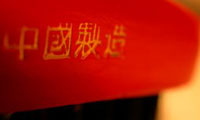




China plans to impose tariffs on its textile exports in an attempt to defuse trade tensions with the United States, its major trading partner.
Importing nations are preparing for a wave of Chinese products when the worldwide system of quotas expires at the end of this year, but experts interviewed by RFA expect the measures to have little effect.
"China is coming under pressure not only from the U.S. government but from countries around the world to prevent its textile and apparel exporters from flooding world markets and throwing millions of workers out of their jobs," Cass Johnson, president of the National Council of Textile Organizations in Washington, told RFA.
"The details, of course, are the important part, and that's what we need to see, exactly what products this applies to and importantly how much the tariffs are going to be," Johnson said.
China's Ministry of Commerce announced Dec. 12 that the government will voluntarily impose tariffs on some textile exports as part of an eight-point plan. The idea is to reduce the difference in price with foreign-made goods and relieve some of the pressure abroad.
The plan is believed to involve imposing tariffs on the basis of quantity rather than value, a move that could help to hold volumes down. China exported U.S. $42 billion of clothing and textiles in the first half of 2004.
China is coming under pressure to prevent its textile and apparel exporters from flooding world markets.
The United States has frequently complained about Beijing's monetary policy, which keeps the yuan pegged to the dollar at what competitors see as an artificially low rate.
Johnson said China's price advantage from currency manipulation alone was estimated at 40 percent. "So, for these tariffs to really be effective, the hike is going to have to be pretty stiff," he said.
But analysts said China's proposed duty hikes are unlikely to make a significant difference to U.S. competitors.
"I doubt the Chinese are going to impose duties that are as high as would make manufacturers here happy, and then there would also be the question if they are imposed on paper, are they imposed in practice," Gary Hufbauer, senior fellow at the Institute for International Economics in Washington, told RFA.
Johnson agreed. "China has a history, and I've seen this happen a number of times over the last 15 years, where it promises it's going to take care of a problem and then, strangely enough, six or eight months later the problem reappears and the supposedly stringent measures China agreed to take have disappeared," he said.
On Dec. 20, the Asian Wall Street Journal reported that China is considering duties of just 2 to 4 percent on six textile categories, a plan unlikely to satisfy the demands of U.S. industry.
U.S. industry representatives say China's proposed duties will have to be very high to make a significant difference.
I doubt the Chinese are going to impose duties that are as high as would make manufacturers here happy.
Lloyd Wood is spokesman for the American Manufacturing Trade Action Coalition, a U.S. industry advocacy group in Washington. He argued that China has taken advantage of quota liberalization in the past to drive competitors out of the market.
"You've got currency manipulation of 30 to 40 percent, you've got export tax rebates, non-performing loans... Maybe 50 percent of the business loans in China non-performing," Wood said.
"And the bottom line was that the 53 percent price drop, depending on the category, gave China a 30 to 40 percent price advantage over all the other players in the world. And so a 5 or 10 percent tariff in no way will effectively diminish the incentive to source textile and clothing products from China," he added.
Wood said the U.S. industry will not ease its pressure for new safeguard limits on Chinese imports, which the U.S. Commerce Department is due to decide in February.
"The pressure is going to not just stay the same, but it's going to increase, especially I think when you see the export surge that's going to come into play in early January and February. I don't think this diminishes the case for safeguards at all," Wood told RFA.
"China is selling things like cotton trousers basically at the price it costs to make the fabric, or less than that price to developing countries."